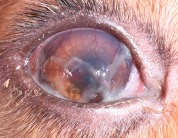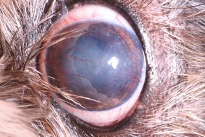Keratoconjunctivitis sicca (otherwise known as KCS or “dry eye syndrome”) results from insufficient tear production. The cause of dry eye is often unknown but is most often considered an immune-mediated disease. Some known causes include congenital disorders, drug-induced, removal of the lacrimal gland of the third eyelid (“cherry eye”), and hypothyroidism. Diabetic patients are also at risk of developing dry eye syndrome due to decreased corneal sensitivity that results in decreased reflex tear production.The disease is seen commonly in certain breeds such as the cocker spaniel, shih tzu, lhasa apso, bulldog, schnauzer, Yorkshire terriers and West Highland white terrier.
 The clinical signs of dry eye include heavy mucus production, redness, rubbing at eyes, cloudy eyes, and corneal ulcers. After an extended period of dryness, the surface of the eye (cornea) begins to develop pigmentation and blood vessels, often causing diminished vision. Having dry eyes results in discomfort and often pain especially if recurrent ulcers develop.
The clinical signs of dry eye include heavy mucus production, redness, rubbing at eyes, cloudy eyes, and corneal ulcers. After an extended period of dryness, the surface of the eye (cornea) begins to develop pigmentation and blood vessels, often causing diminished vision. Having dry eyes results in discomfort and often pain especially if recurrent ulcers develop.
Treatment goals for dry eye include stimulation of tears, lubrication, and decreasing the scar tissue to improve comfort and vision. In the last few years, the use of Cyclosporine and Tacrolimus (both topical immunosuppressants) has made an incredible difference in the successful treatment of KCS.
 Lubricants such as Optixcare with hyaluron have also helped in keeping the patient comfortable because it may take up to 4-6 weeks for the topical immunosuppressant to be effective. Often the renewed tear production is dependent on the presence of the medications, so once a medical treatment plan is started, it is important to continue the medications as directed, and crucial that you have your dog checked as directed to monitor treatment success. Treatment for KCS is lifelong and adjustments may need to be made based on response to treatment.
Lubricants such as Optixcare with hyaluron have also helped in keeping the patient comfortable because it may take up to 4-6 weeks for the topical immunosuppressant to be effective. Often the renewed tear production is dependent on the presence of the medications, so once a medical treatment plan is started, it is important to continue the medications as directed, and crucial that you have your dog checked as directed to monitor treatment success. Treatment for KCS is lifelong and adjustments may need to be made based on response to treatment.
Neurogenic KCS
Any acute onset one-sided dry eye with or without dry nose (same side as dry eye) or KCS not responding to conventional dry eye treatment should be considered to be neurogenic in origin. Treatment of neurogenic KCS comprises identification and treatment of the underlying lesion where possible. This may encompass a thorough ear canal exam and head/skull imaging. In addition to the above medical therapy, systemic therapy consisting of oral pilocarpine may be necessary to stimulate tear production. Pilocarpine is dosed in an increasing incremental manner in order to minimize the risk of unwanted side effects.